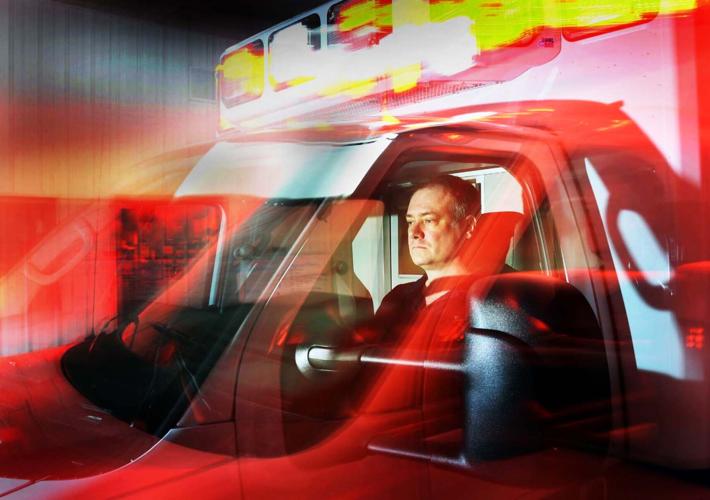By day, Martin Healey teaches science classes at Waseca High School.
At home, his pager stays on for 12-hour stretches two nights each week and on occasional weekends, alerting him to calls for the Wells Community Ambulance Service, with which the 48-year-old has served over the last dozen years.
Such is the life of an EMT with a rural emergency medical service.
“Recruitment never stops,” said Healey, a past Wells squad captain and dedicated public servant.
“We try to put together a class of about 10 (candidates) every year, but training is a big commitment (160 training hours), and we know not everyone will pass.”
With two ambulance rigs and 20 EMTs serving a local population of about 2,400 plus the surrounding area, Wells is decently positioned to provide emergency medical transport.
But Minnesota’s rural EMS system isn’t necessarily on solid ground overall, with some areas lacking adequate numbers of trained EMTs and others short on dollars.
Such challenges led the Center for Rural Policy and Development to host a recent webinar that attracted 150 virtual attendees.
“Rural health is all about access,” said panelist Mark Jones, executive director of the Minnesota Rural Health Association.
“When you call 911, you hope someone will respond. Primary service area boundaries don’t need to stay so static.”
That push and pull between primary service areas, resulting in occasional reluctance to collaborate or consolidate emergency medical services, is one issue at hand.
Kelly Asche, a research associate with the Center for Rural Policy and Development and the webinar’s moderator, provided background on the topics.
“Minnesota has eight EMS regulatory board program regions and more than 250 ambulance service areas,” Asche said.
“That’s better than in many other states — but what’s stopping a strategy of collaboration?”
Long history
The origin of ambulance services is traced to the Civil War and evolved with the founding of the American Red Cross and subsequent wars, Asche said.
When the federal government began viewing injuries from car crashes and cardiac incidents as public health concerns and infused financial support (via the U.S. Dept. of Transportation) during the 1960s and ‘70s, EMS services took off across the nation and became points of civic pride.
“Communities started ambulance services with those funds,” Rasche said. “They were staffed by people’s friends and neighbors and had a presence at football games.
“There was pride in the history of being able to offer those services — and that can be hard to untangle.”
In the 1980s, the federal government’s financial support retreated, laying the costs at the feet of each local service.
Today, that contributes to the unevenness across the state; the annual price tag to operate one ambulance rig with 24/7, 365 on-call access is between $500,000 and $600,000.
And that’s with many rural EMS programs dependent on “volunteers,” who are often modestly compensated but not at levels truly commensurate with the time they give and the services they provide.
“Is it time to reconsider volunteers in general, and do we need to get to a place where each agency has paid staff?” asked Rasche. “And how is that paid for?”
As it is, too many EMS budgets are balanced on the backs of those doing the work, Jones said.
“I don’t know if we need to go away from volunteers completely — there’s a place for it somewhere — but can they be relied on as the main labor force? Absolutely not,” Jones said.
With volunteer EMS crews, variability is the rule when it comes to whether their employers continue paying them for the periods when they are called away from work for emergency runs — and if they are paid, then the employers are the ones shelling out the dough.
“But a taxing district would be a hard thing to sell in my rural communities,” said Ann Jenson, the Dawson-based executive director of the Southwest Regional Program of the MN EMS Regulatory Board and another webinar panelist.
A lot of communities, she emphasized, tend to fund fire departments at much higher rates than ambulance services but continue to rely on the latter nevertheless.
“As our services get smaller and our patients get bigger, we rely on law enforcement and fire departments to help lift,” Jenson said.
“We are a team and we need each other, so we need to figure out how to make this work.”
Collaboration key
Gordon Vosberg, director of EMS for CentraCare Health in Monticello and a webinar panelist, believes finding a way to collaborate where possible — even if services aren’t necessarily consolidated — might be the best path.
For instance, his division of CentraCare had six independent ambulance services, each with its own manager. About 2½ years ago, they began running staff orientations at the same time, recruiting as a group, purchasing as one entity and training together.
“We’re now down to two dispatch centers so we can control things more, and the two larger primary service areas support the lower primary service areas,” Vosberg said.
“Even with that integration, the important local piece with community-based collaboration between police and fire departments is something no one wants to lose.”
Joel Polzin, fire chief in Nicollet for the past several years and a three-decade veteran of the Nicollet Fire Department, sees the wisdom in that approach.
“The ambulance services rely on us, and there are times when the fire department gets there first,” Polzin said. “Then we have a lot of the vitals taken so when the ambulance crew arrives, they can concentrate on the transport.
“We have to work together to provide the best care we can, and it takes a cooperative effort to provide for the health and safety of our citizens.”
Lest urban residents think rural EMS services are not their problem, consider: If you’re traveling across the state and suffer a medical emergency or are injured in a car crash in a remote location, how important will an adequate EMS crew and quick response time be to you?
“In an emergency situation, four to five minutes might seem like 15 to 20 to the patient,” Polzin said.
“In reality, the volunteers in different communities are fairly quick at getting people where they need to go.”
Healey is among those committed to doing his part to help his neighbors in need, and he’ll likely continue “as long as my back can take it,” though the existence of hydraulic cots offers a literal lift when loading and unloading patients.
Healey added an emergency responder class to his teaching repertoire at Waseca High School last year, and he said the response from students has been “fabulous.”
“The kids understand the need for it,” Healey said.
That must be encouraging news to professionals such as Vosberg, Jones and Jenson, who are daily puzzling out ways to support rural EMS programs that exist to protect and serve citizens in times of crisis.
“We’d like to align all of this and sustain the volunteers we have,” Jenson said. “Recruitment and retention is the million dollar question, and it will take all of us working together to figure it how we do it going forward.”





























Commented
Sorry, there are no recent results for popular commented articles.